PPC
Instagram vs Facebook for Marketing: Everything You Need to Know

Instagram and Facebook (now known as Meta) may be owned by the same parent company, but the two social platforms are different—very different. For the casual user, this doesn’t matter much beyond preference. (I have to limit myself from Instagram scrolling with a 15-minute daily limit, for instance, but I haven’t logged into my personal Facebook in years and haven’t wanted to.)
But for marketers looking to grow organic reach, it’s important to understand Instagram vs. Facebook for your business goals to decide which platform works best for you and how to use each effectively.
Similar shapes, same white accent, very different vibes even with these logos.
In this overview, we’ll cover the key differences between Instagram and Facebook, including:
Let’s start with some background information.
Instagram vs Facebook: Background
People love both of these social networks: According to Hootsuite, 14.5% of active social media users report Facebook as their favorite social network, while 14.6% choose Instagram. This shouldn’t be a surprise. Both Instagram and Facebook have been cornerstone social platforms for a decade now.
But the platforms were created with different goals in mind in very different environments, and it’s a good idea to understand that before we get into the differences today. Here’s a quick overview.
| Year Founded | 2010 | 2004 |
| Founders | Kevin Systrom and Mike Krieger | Mark Zuckerberg, Eduardo Saverin, and Dustin Moskovitz |
| Founding Location | Silicon Valley, CA | Cambridge, MA |
| Tagline | Capture and share the world’s moments | Move fast together |
| Initial Medium | Mobile | Website |
These platforms were created a few years apart, but Instagram was launched after the launch and market saturation of the iPhone ushered in the mobile-first era and after Facebook’s rise to prominence changed our relationships with social media.

Instagram launched the same year The Social Network came out.
Now let’s get into the key Instagram vs. Facebook differences you need to know.
Instagram vs Facebook: Audiences
Both social media networks have huge audiences all over the world. Instagram and Facebook hit 1 billion users in 7.7 and 8.7 years, respectively, and they’ve continued to grow since.
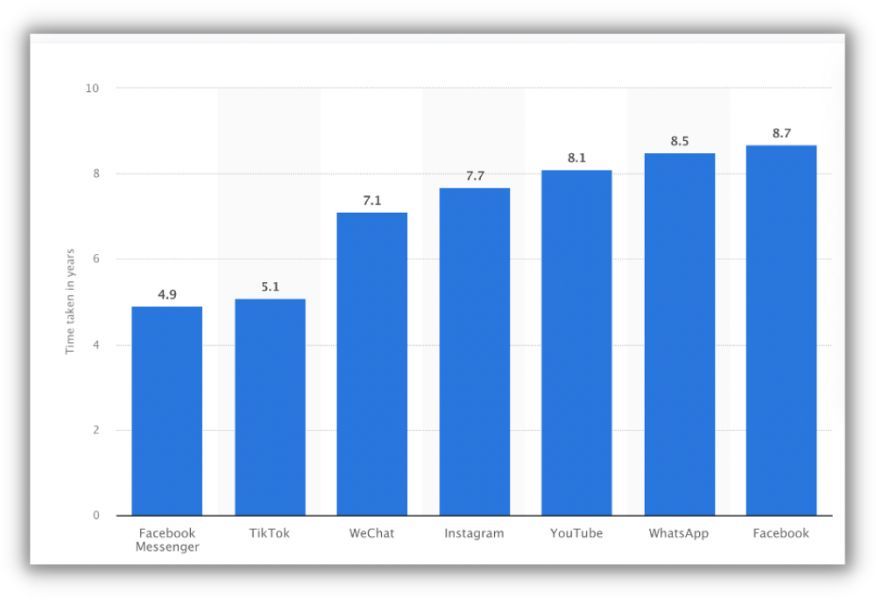
The time social networks took to reach 1 billion users, via Statista.
Still, there are some differences—including the number of users and demographics of users.
Number of users
Both Facebook and Instagram have substantial users, but Facebook’s audience is significantly bigger. Facebook has 2.9 billion monthly users, while Instagram has 2 billion monthly users.
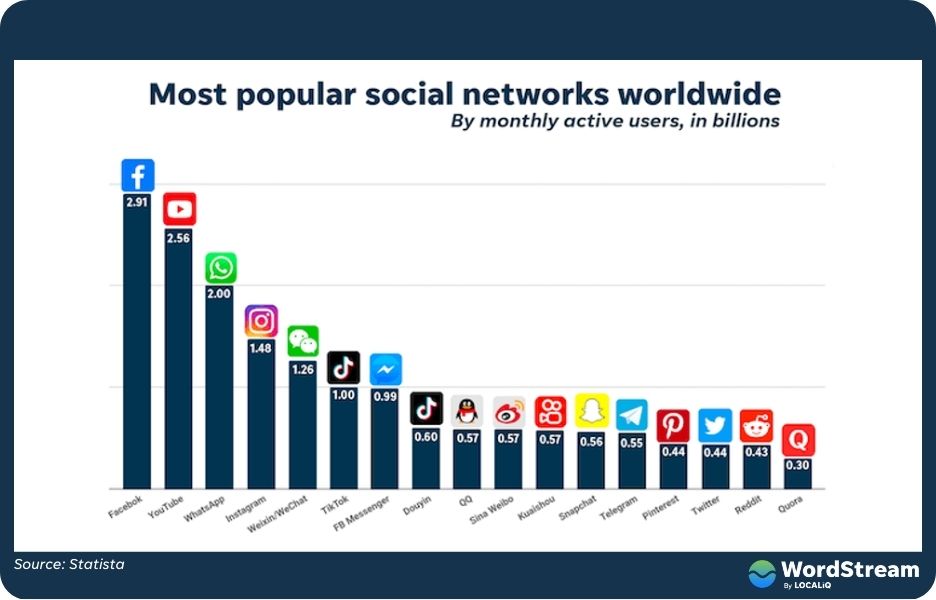
It’s important to note that Facebook’s user growth has leveled in the last five years, while Instagram has continued to grow steadily.
Age and gender identity of users
For both Facebook and Instagram, the minimum age to create a profile is 13 years old. This is important to note for marketers because it means that there are kids on both platforms.
Still, teenagers under 18 make up only about 7% of Instagram users. More than 60% of Instagram users are 18-34 years old, with women making up the slight majority for this age range.
That means if you’re targeting potential customers in their 20s and early 30s—especially women in this age range— Instagram is a great place to reach your audience.

Instagram users by age via Statista
Facebook, on the other hand, skews older, with men making up the majority. Close to 50% of Facebook users are between the ages of 25 and 44. Nearly 30% of all Facebook users are men between the ages of 25 and 44.
So if you’re looking to reach men in these age groups, it’s a good idea to look into Facebook.

Facebook users by age via Statista
Location of users
Both social platforms are used by people globally, and their usage per country is pretty consistent. In fact, Instagram and Facebook have the same top four countries in terms of the number of users: India, Indonesia, Brazil, and the United States.
In general, you don’t need to make location-based decisions between Instagram and Facebook. But it’s a good idea to double-check the specific country or region that you’re targeting. For instance, there is some difference in social media usage between people who live in rural, suburban, and urban areas. According to PEW research, Facebook is the most commonly used social media network in rural areas, just above YouTube.
Instagram vs Facebook: Engagement
Knowing your audience and potential audience is great, but as a marketer, you know that engagement is how to determine whether or not your social media strategy is effective.
Types of engagement
The most important engagements for the Instagram algorithm are:
- Likes
- Comments
- Saves
- Profile visits
- Time spent on page
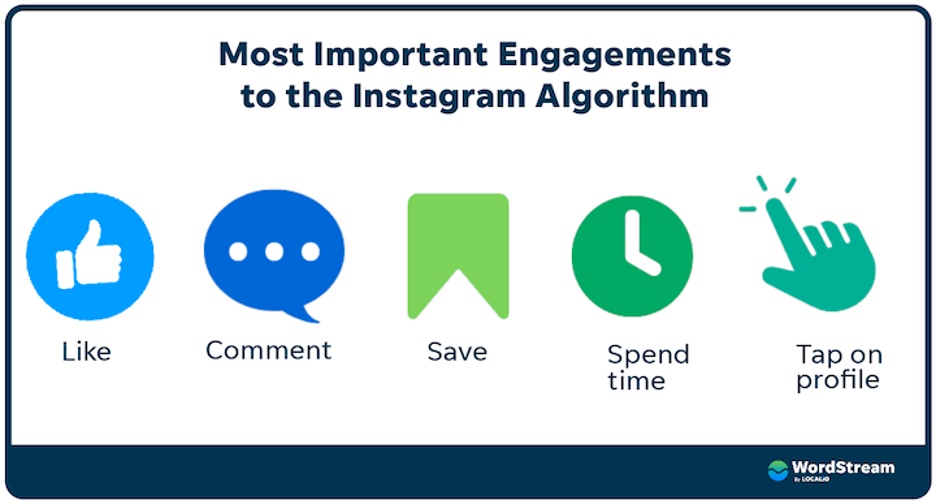
The most important engagements for the Facebook algorithm are:
- Reactions
- Comments
- Shares
- Link clicks
- Time spent on page
Engagement benchmarks
The number of engagements is useful to track and measure your organic social strategy, but it’s good to know benchmarks, too. The social scheduling and reporting platform Hootsuite analyzed social media posts to determine engagement benchmarks for organic Facebook and Instagram posts.
Here are some average engagement benchmarks for Facebook:
- Post engagement vs page fans for all post types is 0.07%.
- Photo post engagement vs page fans is 0.12%
- Video post engagement vs page fans is 0.08%.
- Link post engagement vs page fans is 0.04%.
- Status post engagement vs page fans is 0.11%.
As you can see, photo posts and status posts have the highest engagement rates. You should still test this out with your audience, but favoring those post types is a great place to start.
Here are some average engagement rate benchmarks for Instagram:
- Engagement rate for all post types is 0.54%.
- Engagement rate for photo posts is 0.46%.
- Engagement rate for video posts is 0.61%.
- Engagement rate for carousel posts is 0.62%.
Again, carousel and video posts are a great place to start whether you’re setting up an Instagram for your brand or reinvigorating an existing page.
It’s also worth noting that the average engagement rates on Instagram are higher than Facebook. This is a good reminder that it’s not always best to compare your engagements on one platform vs. the other since people use Facebook and Instagram differently.
Time spent on Instagram vs Facebook
Remember when I admitted that I have to institute a limit on how much time I spend on Instagram? I’m not the only one that finds the platform addictive: Last year, users spent an average of 11.7 hours on Instagram each month.
That’s nothing compared to Facebook, though. Users spent 19.7 hours per month on average on this platform.

And that’s per user!
That’s a lot of opportunity for you to engage your audience—as long as you’re promoting and sharing the right content from your brand’s profile.
Instagram vs. Facebook: Content
There are many reasons to open a social media app. You could open it out of habit when you’re bored, out of curiosity when you’re looking to see what friends and family are up to, or out of necessity when you’re considering a purchase and want to see the product in action.
It’s impossible to know what your audience is looking for every single time they log into Facebook or Instagram, but you can use existing data to make some educated guesses—and some more appealing content.
Here’s what Facebook users tend to look for on the platform:
- 54% look for funny or entertaining content.
- 55% follow or research brands and products.
- 59% keep up to date with news and current events.
- 71% message friends and family.
- 64% post or share photos and videos.

Most people go to Facebook to interact with friends and family. This means you’ll want to be sure to make your business page isn’t a distraction—avoid being too salesy there, and try instead to be conversational.
And here’s what Instagram users tend to look for on the platform:
- 61% look for funny or entertaining content.
- 62% follow or research brands and products.
- 51% keep up to date with news and current events.
- 51% message friends and family.
- 70% post or share photos and videos.
As you can see, more people are turning to Instagram to research brands and products. That’s a good signal to use this social network to highlight product reviews and customer testimonials with lots of photos and videos.
Types of content
The biggest difference between Instagram and Facebook content is that Instagram posts require a photo or a video. Facebook allows for different types of content, including text-only posts, link sharing, and more. Here’s a quick review of the content you can share on Instagram vs Facebook.
Types of content that you can share Instagram:
- Photos. Instagram posts feature photos or video content. While photos do tend to get less engagement, that doesn’t mean you want to skip them entirely. Instead, opt for carousel posts to share lots of pictures at once for better engagement.
- Stories. Instagram Stories are ephemeral video or picture posts that get lots of engagement—not in small part because they’re the first posts you see at the top of your Instagram feed. This is a great place to re-share content where customers have tagged your brand.
- Instagram Live. Instagram Live allows you to go on video and engage with your customers in real-time, which is a great way to offer Q&As or get people involved in product announcements.
- Reels. Instagram Reels are 15- or 30-second videos that can get tons of reach on Instagram. Unlike Instagram Story content, Reels live on your feed. Plus, they’re a good place to re-share TikTok content if you’re creating it.
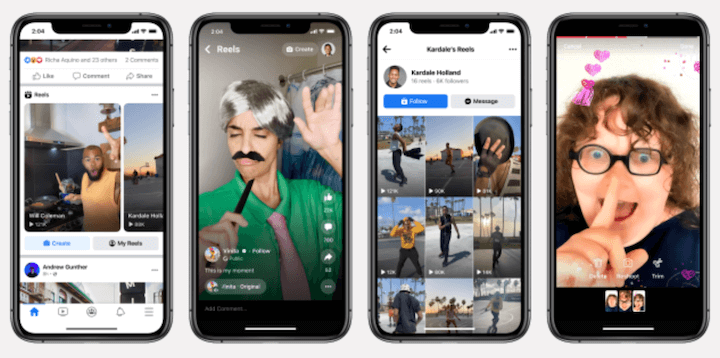
Here’s the type of content that you can share on Facebook:
- Status updates. You can use status updates to share posts with text, photos, videos, and even links to your profile feed.
- Events. You can set up Facebook events for any in-person or virtual programming that you’re running so that your followers can see and RSVP to attend.
- Live. Facebook Live is similar to Instagram Live—it offers a way to broadcast and engage your following in real time.
- Photos or videos. While Instagram is a more visual network, Facebook still allows for photos and videos. And Facebook users still want them. So be sure to share brand photos, products, and even behind-the-scenes content here.
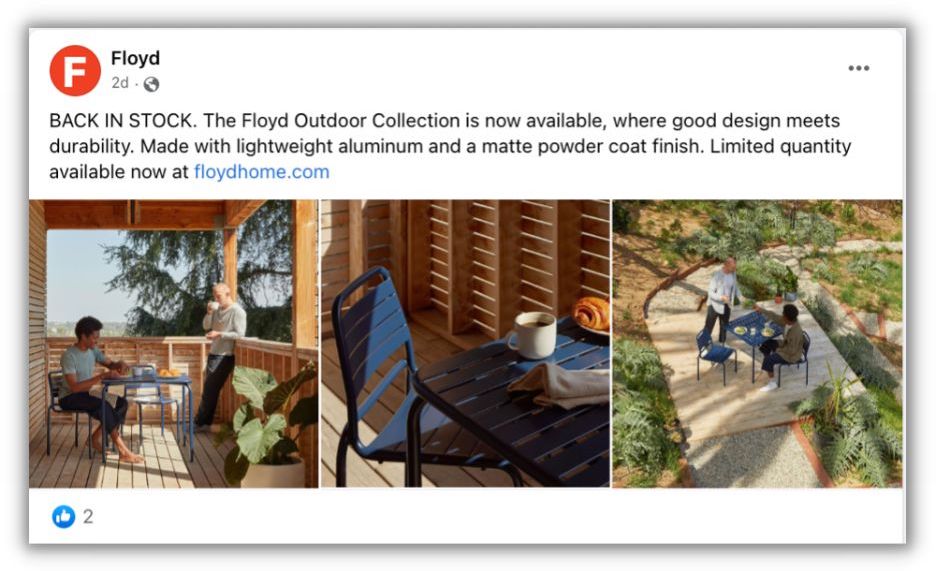
Furniture company Floyd uses Facebook status updates with photos and links to let followers know when items are back in stock.
Instagram vs Facebook: Industries
To be clear, a business in any industry can create a profile and grow a following on Instagram or on Facebook. But certain industries are better suited to one platform or the other.
Industries on Instagram
The industries that tend to perform well on Instagram are ones that easily lend themselves to the visual nature of the content, the direct connections with customers that platform enables, and the strong social media influencer market.
That includes:
- Health and beauty: Not only is the beauty industry incredibly visual, but it’s incredibly personal. In fact, Harvard Business School found that 67% of beauty shoppers look to influencers to find new products. This makes Instagram a no-brainer for growing your organic following and growing brand awareness.
- Clothing and accessory brands: Like the beauty industry, fashion relies heavily on visuals in marketing. Also, like the beauty industry, influencers play a huge role in growing fashion brands on social media. 50% of Instagram look to influencers for outfit or clothing inspiration.
- Food and restaurants: One of the reasons that the food industry does so well on Instagram is the way the platform encourages user-generated content. Food brands can let their customers speak for them—which, as we know, is always so much more effective.

Industries on Facebook
Here are a few industries where Facebook works particularly well for growing organic following and encouraging engagement:
- Real estate: Remember that the demographic of Facebook users is a bit older than Instagram and that the platform allows for visual content as well as link sharing, something that is crucial to an industry like real estate.
- Travel: Like real estate, travel is so visual and relies on links and more information than is often available in Instagram’s content formats. Hootsuite found that travel pages on Facebook earned an average of 591,000 impressions, compared to 351,000 profile visits to travel business accounts on Instagram.
- Education: Facebook is the most commonly used social media platform for educational marketing. This could be because the average age of the Facebook user is older—and so more likely to be a parent with a child enrolled in school. Either way, if you’re working for an ed-tech company or higher ed institution, it’s worth testing out with your account.
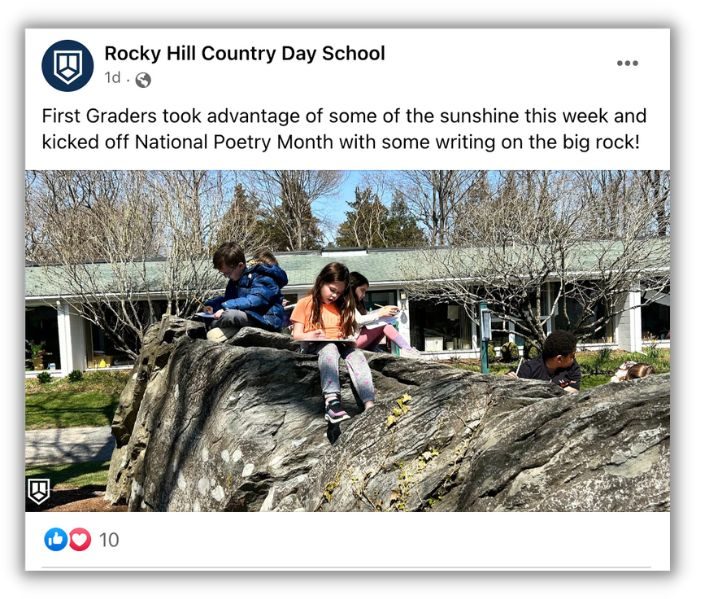
Business types on Instagram and Facebook
While any business type can grow a following on Instagram and Facebook, some are better suited to the platforms and more likely to succeed than others. Business-to-consumer brands tend to have more success growing organic social followings on any platforms, but especially Instagram and Facebook. When you consider the nature of the connection—whether it’s live videos or account-to-account communications and exchanges—this makes sense.
One business type that should definitely be on both Facebook and Instagram? Ecommerce. Instagram and Facebook both support direct sales, and they’re both incredibly effective. But more marketers report that Instagram has the highest ROI when selling products.

Instagram vs Facebook: Advertising
Your organic strategy for Instagram and Facebook should be independent of your advertising strategy. But it should be complementary. The more you grow and learn about your organic audience, the more you’ll be able to target your advertising if you do decide to run ads on either platform.
Here are the types of Instagram ads you can use:
- Image ads
- Instagram Story ads
- Video ads
- Carousel ads
- Collection ads
- Explore ads
- Instagram Shopping ads
- Reels ads
And here is an overview of Facebook ad types:
- Image ads
- Video ads
- Carousel
- Instant Experience
- Collection
- Facebook Lead ads
- Slideshow
- Facebook Messenger ads
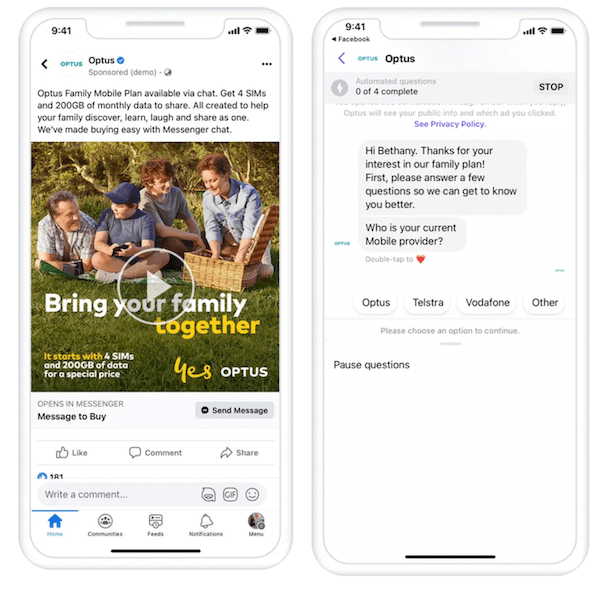
Facebook Messenger ad example
Instagram vs Facebook: You don’t have to choose
Most people are on upwards of 5 social media platforms, so if you do end up favoring Facebook over Instagram or seeing more success on one than the other, chances are you’ll still be reaching a good portion of your intended audience to some extent.
But the good news is that you don’t really need to choose. Use the differences above to determine your strategy for each platform to make sure you’re making the most of your time and your content on both Instagram and Facebook.
PPC
19 Best SEO Tools in 2024 (For Every Use Case)

Whether you’re a local mom-and-pop shop or a multinational enterprise, SEO is still the best play for long-term traffic growth and lead generation. A single optimized blog post, web page, or video can attract thousands of qualified visitors for years—and you don’t have to spend a dime to promote it.
That said, SEO isn’t easy. Every marketer knows how valuable the top of a Google results page is, and it keeps getting harder to own that real estate.
That’s why we’ve trialed, tested, and categorized the best SEO tools available in 2024. Whether you’re publishing your first blog post or optimizing a 5,000-page website, there are SEO tools here to help.
Contents
💡 Rank faster with this free guide: 10 Tangible & Free Ways to Get on the First Page of Google.
What are SEO tools?
In broad terms, SEO tools are software that helps you automate, streamline, or support your SEO strategy.
More specifically, SEO tools can help with:
SEO tools come in a few varieties. Some are feature-rich, comprehensive software with several tools to tackle many SEO tasks. Ahrefs is a good example of a comprehensive SEO tool since it helps with on-page SEO, off-page SEO, site audits, and more. Our Keyword Tool is a point-solution since it has one function—to help you find the best SEO keywords to target.
What is the most effective tool for SEO?
That’s like asking, “What’s the best vehicle?” Do you want to haul a lot of people, a lot of stuff, or do you just want to go fast?
Like car shopping, picking your SEO tool starts with understanding your needs. Here are some questions to consider:
- Are you new to SEO or a power user of SEO tools?
- What’s your budget?
- Do you have specific jobs to do, like auditing a blog with 5,000 posts or doing initial keyword research?
- How big is the team that’ll use the SEO tool?
- What type of organization is it (a marketing agency, affiliate marketing group, ecommerce shop, SaaS company, etc.)?
While each use case has its own set of needs, there are a few foundational characteristics we used to compile our best SEO tools list, including:
- User experience: Is the interface and workflow intuitive? Does the design help new users find what they need quickly?
- Value: Does the cost justify the software’s capability? Is it competitively priced versus similar tools?
- Feature/use-case fit: Does the tool have everything you’ll need to complete the task it’s built for?
- User feedback: Positive reviews and high ratings on sites like G2 and Capterra.
Best free SEO tools
These SEO tools are either completely free or have a robust free tier with plenty of functionality.
1. Exploding Topics for SEO keyword trends
Exploding Topics is a neat little tool that helps you get in early on soon-to-be popular topics. The tool constantly scans the web, looking for increasing patterns of searches and mentions for any specific term.

Note that you can’t enter any old search term to see what’s trending. But you can choose from a bunch of topics that may be important to your brand.
The data doesn’t just come from search engines (although the software does “listen” to millions of searches). When you see a trending topic, it’s because it’s also been mentioned, commented on, and discussed all over the internet. That’s why this tool is good at exposing not just what people search for but also what they’ll likely search for in the near future.
There’s no cost to pop in anytime and see what’s trending for each category. The paid plans start at $39 and give you tracking, alerts, and detailed reports (like tracking specific product categories).
2. WordStream’s Free Keyword Tool for unlimited keyword research
One of the hardest parts of SEO is finding keywords with the right balance of search volume and low difficulty. Our Free Keyword Tool helps you overcome that hurdle by quickly surfacing a list of relevant keywords and the data you need to pick the best options.
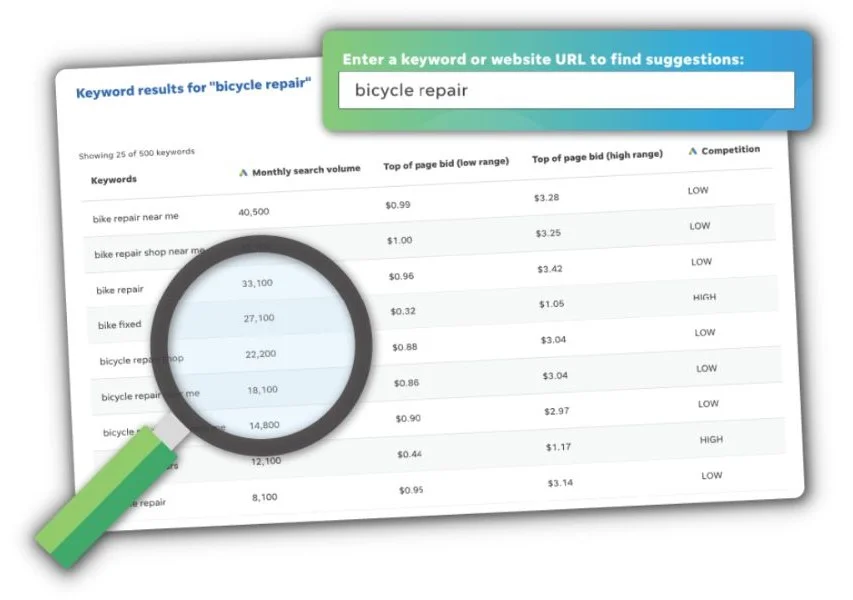

I like to use it once I’ve brainstormed a list of seed keywords (terms I think people might search for). Just drop the word or phrase in the search bar, and you will get a list of related terms, plus their monthly search volumes and competition levels. It’s pretty easy to spot those high-volume, low-competition keyword unicorns.
The price of the tool is in the name. It’s always free for an unlimited number of searches.
3. Animalz Revive for refreshing SEO content
Over time, SEO blog posts often lose their ranking to new content. Revive, from the content marketing agency Animalz, locates these decaying assets on your blog.
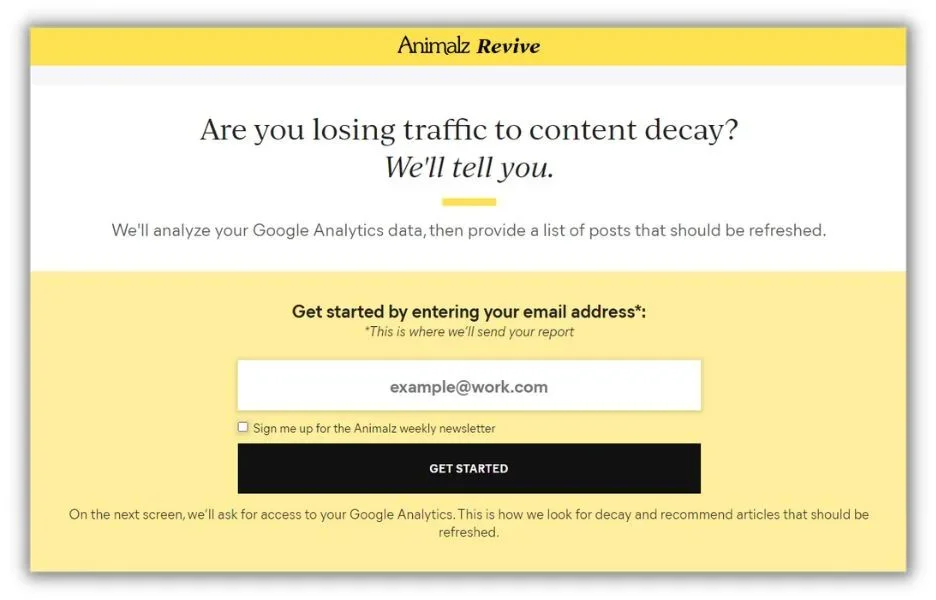

The tool works by reviewing your Google Analytics (you have to give it access) to spot blog posts with a downward traffic trend. Once it’s finished, you’ll get an emailed report with a list of content that could rank and get more traffic once it’s refreshed.
The tool is free, but you do have to give up your email address to access it.
4. Similarweb for competitive SEO analysis
Similarweb gives you a sneak peek at the performance and ranking of any public website on the internet. Its free version is surprisingly comprehensive.
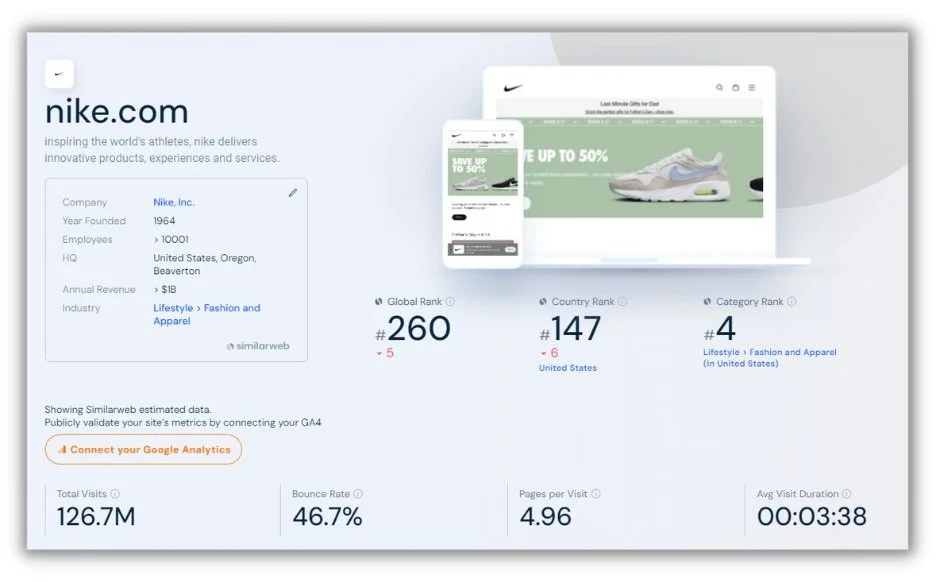

Enter a URL and scroll to see estimated traffic and engagement stats, site traffic demographics, traffic sources, and more. You can even compare two websites side-by-side.
I wouldn’t take Similarweb data as gospel. It pulls “digital signals” from millions of locations across the internet and creates statistically significant estimates. It’s excellent for directional insights, though. If five of my competitors show a lower bounce rate than the pages I’m working on, it’s a signal that I need to make some user experience improvements.
Basic website analysis is free on Similarweb. There are several data points, like top outgoing links and referral traffic sources, you’ll have to pay for.
5. LocaliQ’s Website Grader for free SEO audits
If you need a quick, easy-to-understand website audit, LocaliQ’s Free Website Grader will do the trick.
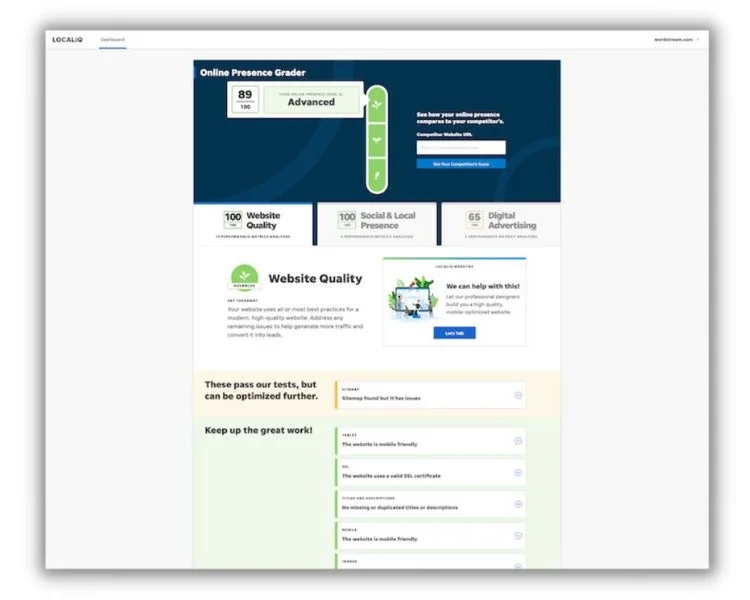

Even though it’s a free tool, you get a lot of information. For example, in your report you’ll see:
- Technical SEO: Site security, site speed, mobile optimization
- On-page SEO: Metadata, word count, alt text
- Off-page SEO: Links from other sources
It’s plenty enough to create a good checklist of SEO improvements.
Free reports are delivered by email, and you can run them as often as you like.
Best AI-powered SEO tools
Many of the tools in this guide have some type of built-in AI functionality for SEO. But we found a few that stand out for their use of AI’s ability to process huge amounts of data and generate SEO insights.
6. Outranking for SEO outlines
There are loads of generative AI content tools out there now. What sets Outranking apart is that it’s focused on helping you create content that’ll rank well on search engines.


With a free account, you can input a search query, location, language, and title, and it will generate an SEO outline that you can customize. It’s really helpful if you regularly write content briefs for others to complete. Like any generative AI content tool, double-check the output and add your own voice.
Outranking pricing tiers start at $29 monthly for five new SEO documents and AI-assisted SEO optimization for existing content.
7. CanIRank for keyword competition
CanIRank is a personalized keyword difficulty tracker on steroids. It reviews your website’s existing SEO clout and then tells you if you can rank for specific keywords.
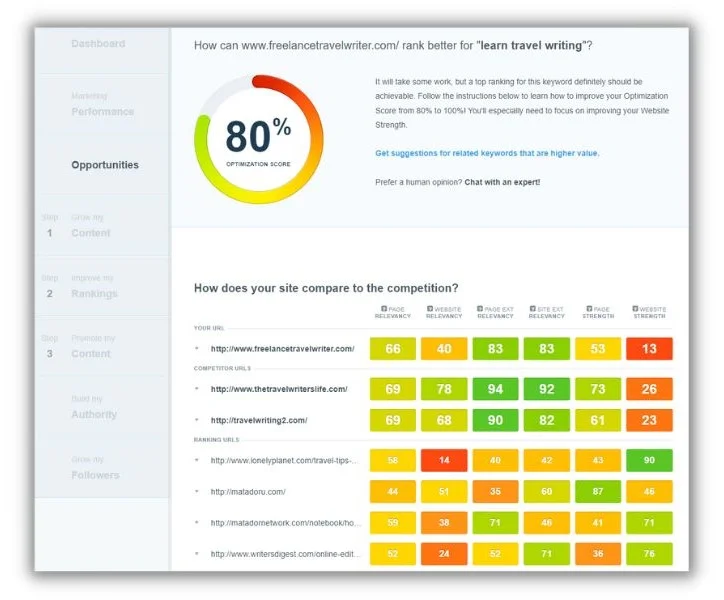

Here’s the real magic of CanIRank. It doesn’t just tell you which keywords to target; it leverages AI to give you specific steps to help your content rank higher.
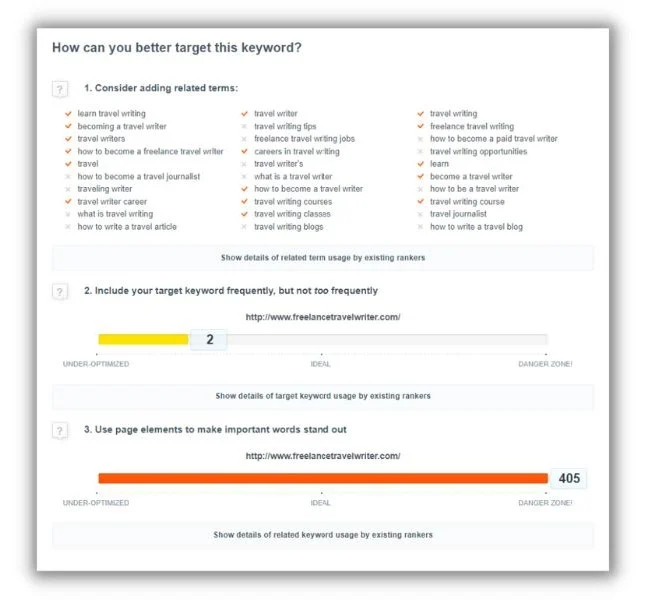

CanIRank lets you review one website for free (plus get five keywords and SEO reports daily without paying). The paid plans for more websites and keyword reports start at $49/month.
8. Keyword Insights for keyword clustering
Keyword Insights is a paid keyword research tool that uses AI in two interesting ways. First, it uses algorithms and machine learning to locate clusters of topics from a single keyword.
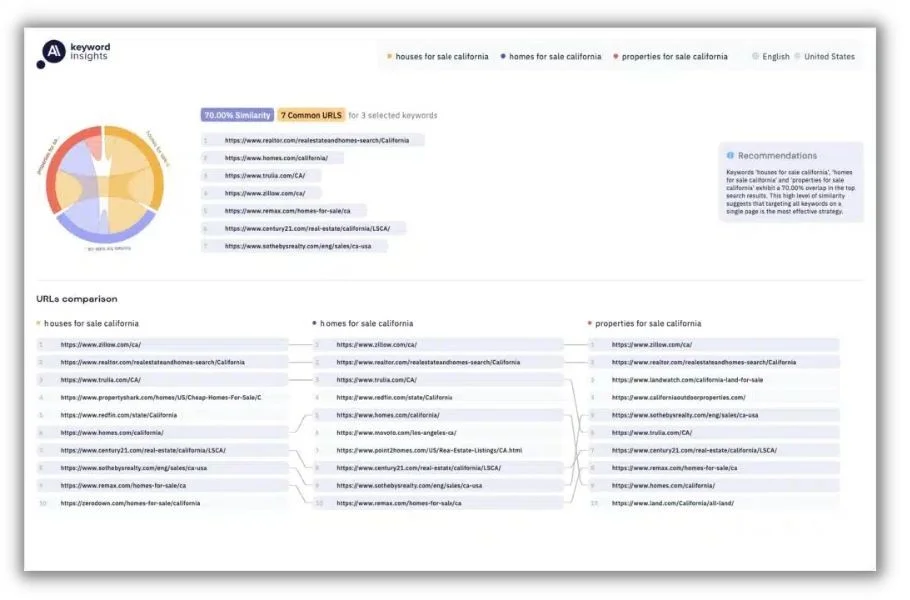

Keyword clusters help you target multiple longtail keywords in a single post or a linked group of posts. Google sees your exhaustive coverage as topical authority on the subject and bumps you to the top of the SERPs for those related keywords.
Then, once you have a keyword cluster defined, Keyword Insights uses AI to generate a brief or outline based on the existing posts in the SERP plus data from Reddit, Quora, and People Also Ask boxes.
A note of warning here. Generative outline creators like Keyword Insights are a great way to create a base outline quickly. But to earn your spot on the SERPs, make sure you add something extra like personal experience, expert quotes, or another facet of the topic other SERP leaders don’t have.
Keyword Insights offers a four-day trial for $1. Monthly paid plans start at $58.
9. Diib for keyword and rank monitoring
Google SERPs are in constant flux. You can gain or lose page-one ranking for any given keyword in a day. Diib uses predictive AI to monitor all sorts of SEO vitals for your website, but the keyword tracking will keep you abreast of turbulent search pages.
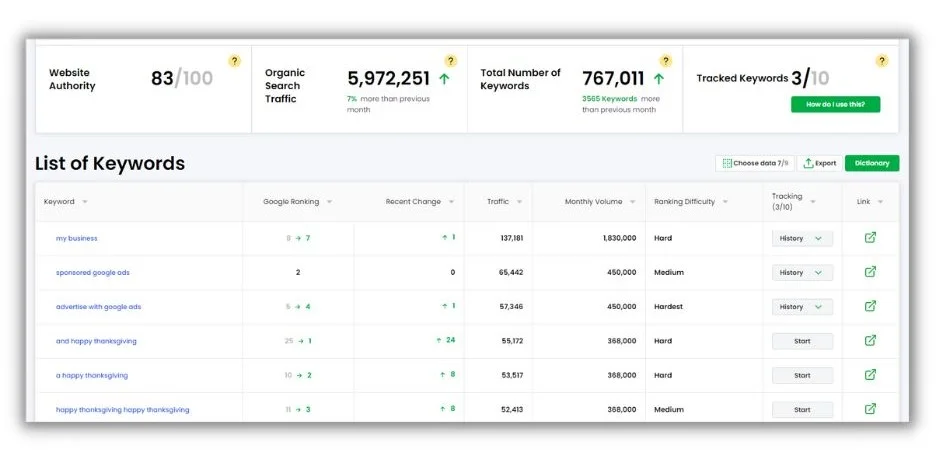

With Diib, you can add high-priority keywords to a monitoring list. It’ll show you those at the top of your keyword reports and let you see their history of performance on the SERP. But the best part is that the tool will also notify you when your rankings change for those keywords. The heads-up lets you take action, like updating the page’s UX or adding new information.
The pricing provided to us was an initial $99 startup fee and $14.99 for each subsequent month.
🛑 Get the free Guide to AI in Marketing and learn the most effective ways to use AI (and the ways you shouldn’t be).
Best local SEO tools
It’s cliche but true: Local SEO is critical for location-based businesses. 77% of people say they’ve used Google to find businesses like a coffee shop, dentist, or HVAC tech nearby. These tools are designed to ensure that you show up on SERPs when those people need you.
10. GeoRanker for location-specific SEO tracking
If your customers come from a specific geography, you need to know if your website ranks for relevant keywords in that location. GeoRanker has a feature that lets you track that.
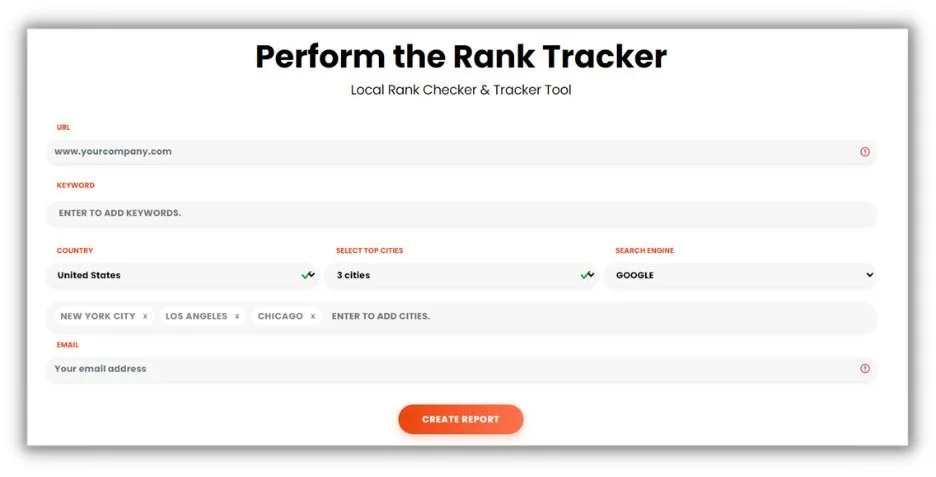

Once you fill out the form, GeoRanker returns a report showing the position—in real-time—your website holds for your target keywords in the cities or countries you’ve picked. You can also see how your rankings have changed and learn where your competitors land on those SERPs.
The tool would be really handy for multi-location businesses, as it allows you to get data for each city you have a presence in.
GeoRanker also has a location-dependent SERP checker that shows the top 100 results for a keyword in different cities. For example, “coffee shop” will have different results in Chicago vs. Phoenix.
GeoRanker gives you limited access to its tools for free, with a monthly subscription plan starting at $99.
11. LocaliQ’s Free Business Listings Grader for directory audits
Online business directories like Yelp and Google Business Profiles are like the digital age’s answer to the Yellow Pages. If you want your local business found online, you need updated, correct information on your listings in those directories. LocaliQ’s Free Business Listings Grader lets you instantly verify your business listing on 20+ online directories.


The Listing Grader is very easy to use. Just enter your company’s name, street address, and postal code, and then the Grader will check it against what’s currently shown on apps like Waze, eLocal, and dozens of other locations. It’s a great way to check many business listings at once.
LocaliQ’s Listings Grader is free for an unlimited number of reports.
12. Yext for review monitoring
Reviews can directly affect how your business appears in local searches. Yext has several features to help you manage your online presence and reputation, but I really like its review management functionality for local SEO.
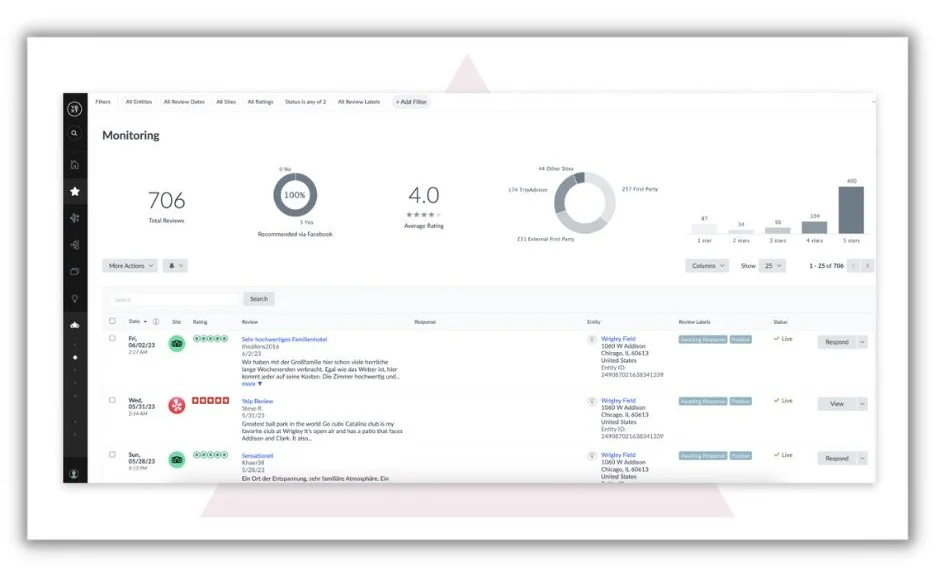

Using API integrations, Yext pulls reviews from all over the web and places them on your dashboard. From there, you can see how people rate your business and what they’ve written. You can also set up notifications so you always know when a new review comes in.
Besides monitoring reviews, Yext lets you respond to (via auto-responder or manually), request, and analyze reviews for their sentiment.
Yext pricing is on request.
Best Google SEO tools
If you succeed in SEO, then Google succeeds. So it’s created an impressive list of tools to help you research, optimize, and analyze all aspects of your website’s ability to rank. These three tools are free, so I’ve not included pricing information individually.
13. Search Console for technical SEO
Technical SEO sounds daunting (and it can be). But Google Search Console helps you track and visualize several aspects of your technical SEO, making it easier to understand and improve.
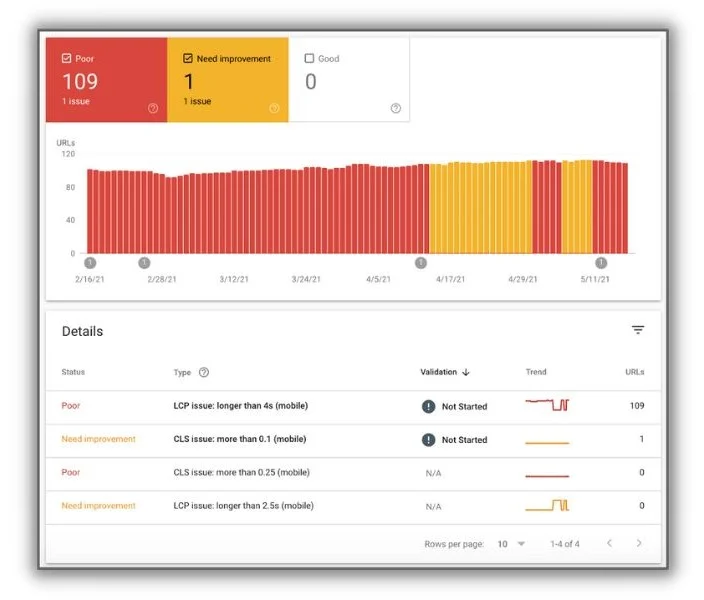

Here are a few ways you can use GSC to see which technical aspects of your website are hurting or helping your SEO:
- Confirm that Google’s crawlers are properly indexing your web pages
- Monitor and troubleshoot your Web Core Vitals or mobile usability issues
- Submit sitemaps
- See security issues
We wrote a guide explaining how to use Google Search Console for technical SEO.
14. Google Trends for timely keyword planning
Google Trends tells you how often a word or phrase is entered into Google relative to the total volume of searches over a set time. Essentially, it’s a real-time keyword popularity report.
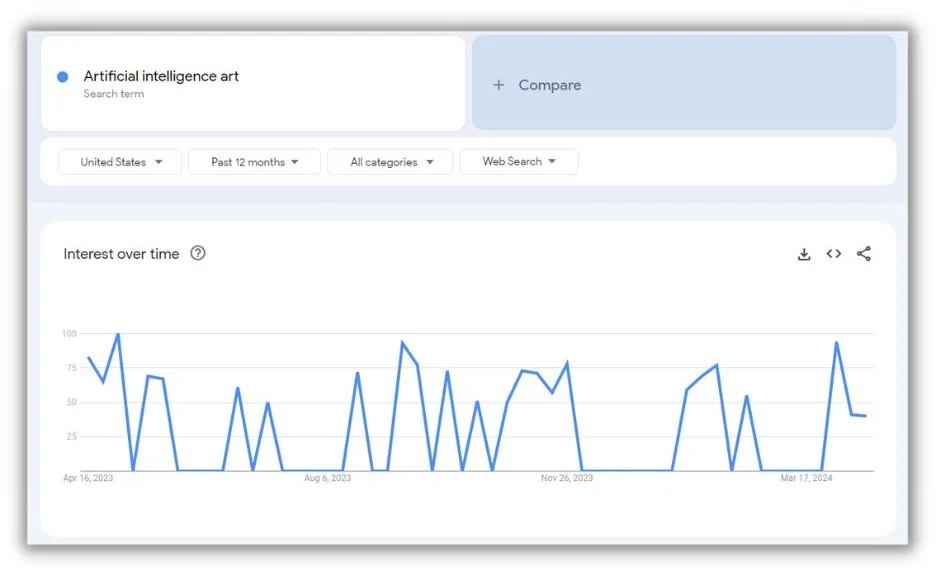

On Search Trends, you won’t see the total number of searches for a keyword. Instead, you’ll see how the search volume changes over time, using the highest and lowest search volumes for context.
You can change the time period, region, and type of search (image, news, Google Shopping, etc.) to see how they affect the trend. You’ll also get a graphical representation of the region you’ve chosen (U.S., worldwide, etc.) that shows the relative searches in each subregion. You even get related terms to inform your keyword strategy.
This guide will help you use Google Trends to its fullest.
15. Google Analytics 4 for SEO performance tracking
Google Analytics 4 (GA4) is a platform that tracks how people arrive at and interact with pages on your website.
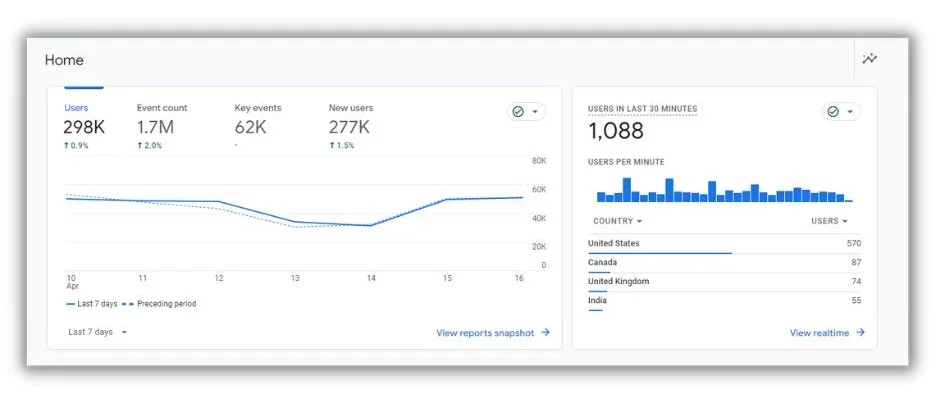

There’s an incredible amount of data that can be parsed in hundreds of ways on GA4. A few of the most valuable insights for SEO are:
- How much of the traffic to your site and individual pages comes from organic search
- Which blog posts and pages get the most traffic
- Which pages are losing traffic from search engines
GA4 is the latest iteration of Google’s analytics platform. Here are a few ways GA4 differs from Universal Analytics, its most recent predecessor.
Best paid SEO tools
If you have the budget, these SEO tools combine rich functionality with excellent user experience. While they all charge a fee, we’ve chosen those that provide the best bang for your buck.
16. Ahrefs for best overall functionality for the money
I’ve used Ahrefs for years for keyword research, rank tracking, competitor analysis, and several other essential SEO tasks. Ahrefs edges out its competition based on the value of what you get, especially for light to moderate SEO users.
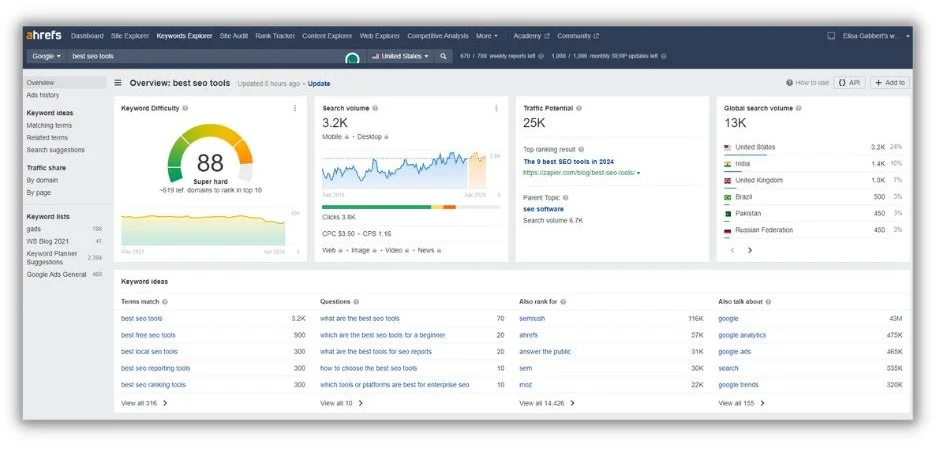

I could write a few thousand words trying to cover all the tricks and tools embedded in Ahrefs’ platform. But for now, here are a few of the functions I use most often to give you a feel for what it can do for you:
- Site Explorer: Enter any website or webpage URL, and Ahrefs will tell you its ranking for specific keywords, how many backlinks it has, where they’re from, estimated traffic, and much more.
- Keywords Explorer: See search volume, difficulty, and which pages rank for any keyword.
- Competitive analysis: Get a list of keywords your website doesn’t rank for, but your competitors do.
Ahrefs pricing starts at $99 per month, with the $199-per-month Standard Plan being what most average users will likely need.
17. Semrush for hardcore SEOs
While Ahrefs is a good value for many SEOs, Semrush delivers more detailed and in-depth data in several areas, making it a better fit for highly technical users.


Take keyword research, for example. Semrush gives you search volume trends, Google PPC keyword data, keyword intent, and search volume and difficulty.
Ahrefs also shines in its technical SEO audit reporting and has a few more rank-tracking features.
Semrush pricing starts at $129.95 (just make it $130!) per month, and its mid-priced plan is $249.95 monthly.
18. Screaming Frog for finding common SEO issues
Screaming Frog works like Google Search Console in that it crawls (hops?) through your website, looking for things that might hurt its performance. The difference is in the issues Screaming Frog looks for and the insights it offers to fix them.


The learning curve for Screaming Frog is a little steep for non-technical SEOs. But if you’ve ever been involved in an SEO audit, it won’t take long to catch on. Once you do, you’ll quickly find things like broken links, problematic titles and meta tags, and incorrect redirects. You can also generate XML sitemaps and site visualizations.
A free version of Screaming Frog lets you crawl up to 500 URLs. The paid plan costs $249 per year and adds functionality like audit scheduling and a near-duplicate content checker. It also allows for unlimited URL crawls.
19. AnswerThePublic for topic ideation
AnswerThePublic is a content topic idea generator. It’s different from keyword research tools because it pulls ideas directly from Google’s drop-down, autocomplete queries (like when you enter “back pain” and Google suggests “…relief” and “…causes”). Then, it presents those keyword variations visually.


Once you’ve entered a root keyword, AnswerThePublic will tell you all the standard information about it, such as volume and the cost per click for search ads. Scroll through the report, and you’ll see a preposition report (keyword variations using “is,” “to,” “with,” and so on). Keep scrolling, and there’s a report that compares the cost-per-click and search volume for several related keywords.
AnswerThePublic has added Bing, TikTok, Amazon, and YouTube to the sites you can target for keyword research.
Once you register, you’ll get three keyword reports per day for free, although some of the data is withheld. Monthly paid plans start at $9, and a lifetime plan starts at $99.
The best SEO tools in 2024
Despite some rumors to the contrary, SEO remains one of the most valuable long-term marketing strategies for driving traffic and generating leads for your business.
But it continues to get more competitive. Manual keyword guessing and piecemeal SEO audits won’t put you in a great position to rank on SERPs. With the right SEO tools in your kit, you’ll punch way above your weight against much larger websites.
Here’s a recap of the best SEO tools available by use case:
- Exploding Topics for SEO keyword trends
- WordStream’s Free Keyword Tool for unlimited keyword research
- Animalz Revive for refreshing SEO content
- Similarweb for competitive SEO analysis
- LocaliQ’s Website Grader for free SEO audits
- Outranking for SEO outlines
- CanIRank for keyword competition
- Keyword insights for keyword clustering
- Diib for keyword and rank monitoring
- GeoRanker for location-specific SEO tracking
- LocaliQ’s Free Business Listings Grader for directory audits
- Yext for review monitoring
- Search Console for technical SEO
- Google Trends for timely keyword planning
- Google Analytics 4 for SEO performance tracking
- Ahrefs for best overall functionality for the money
- Semrush for hardcore SEOs
- Screaming Frog for finding common SEO issues
- AnswerThePublic for topic ideation
PPC
97 Marvelous May Content Ideas for Blog Posts, Videos, & More

Author Fennel Hudson once wrote, “May, more than any other month of the year, wants us to feel most alive.”
You can imagine strolling through a field of newly bloomed wildflowers or feeling the breeze from your open windows on a road trip.
We’ve curated a collection of May content ideas for just about every channel—blogs, social posts, email, and video—designed to engage your audience during this special time of year.
Contents
💡 Want to plan the rest of your year in one place? Get the 2024 Marketing Calendar for ideas, tips, and trends for every month of the year.
May holiday content ideas
There’s lots to celebrate this month, from moms to Mexican culture. These May holiday content ideas will get you in front of your audience right when they’re ready to enjoy the big day.
Cinco de Mayo (May 5)
Officially, Cinco de Mayo commemorates Mexico’s military victory over France at the Battle of Puebla in 1862. Colloquially, it’s a day to appreciate Mexican culture.
Here’s a really cool content idea for this holiday: create a video with activities for kids showcasing Mexico’s traditional music, food, and history.
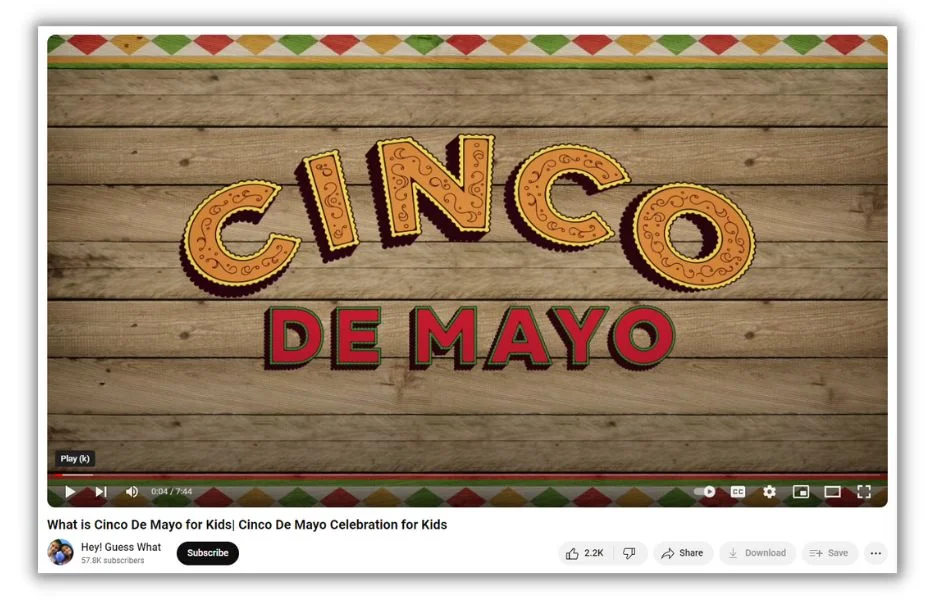
This is an ambitious project, for sure. You don’t have to go that big. There are several other ways you can fiesta on your feeds this Cinco de Mayo.
- Create a calendar of local Cinco de Mayo events.
- Write a blog post about traditional foods and links to recipes.
- Ask followers to comment with their favorite Mexican restaurants.
- Share a list of Mexican heritage centers and museums if there are some in your area, then tag their accounts in the post for extra reach.
- Post a video with examples of traditional Mexican music or images of traditional Mexican dress.
Mother’s Day (May 12)
Moms are the often-unsung heroes in our lives. We’d include the people who step up as stepmoms and mother figures to so many of us on that list.
For all they do, moms deserve a special day. You can help your customers give it to them by publishing a gift guide with ideas for every type of mom.


That’s just the tip of the ideation iceberg for Mother’s Day content. Try asking questions on social media or sharing favorite Mother’s Day memories.
- Ask people to share their favorite mom-ism (Like “because I said so”).
- Make some funny “A day in the life of a busy mom” videos.
- Write up a list of stores and restaurants offering Mother’s Day specials.
- Have moms comment on their favorite Mother’s Day ever.
- Show followers how to make the perfect breakfast in bed.
Here’s even more inspiration for your Mother’s Day social media posts.
🛑 Get a full year of social media posts in this Copy & Paste Social Media Calendar.
Memorial Day (May 27)
Memorial Day messaging has an interesting bifurcation. The meaning behind the day is a somber reminder of the military men and women who gave their lives in service of our country. At the same time, Memorial weekend is the unofficial start of summer, full of pool parties and barbeques.
If you want to address the first theme, an Instagram Reel highlighting the day’s history is a great choice.


There are plenty of ways to engage your audience with the second theme. Promotions, party planning, and cooking tips are all popular options.
- Send your email subscribers a plan for the perfect Memorial Day party with lists of supplies, decoration ideas, and sample menus (use these Memorial Day subject lines).
- Simply share your Memorial Day hours in a social media post.
- Share a list of weekend road trip ideas, small towns to visit, historical sites to see, etc.
- Curate some refreshing summertime cocktail and mocktail recipes and publish them in a blog post.
- Run a Memorial Day promotion with discounts, BOGO offers, or free shipping.
Pop culture May content ideas
Pop culture social media posts are engagement gold (people love their fandoms!). May is full of days dedicated to popular books, movies, and more. Lean into those topics, and you’ll attract many people to your posts.
Harry Potter Day (May 2)
Harry Potter is an enduring cultural phenomenon, with fans flocking to themed conventions, parks, and events. Not to mention, #harrypotterday has nearly 38k posts on Instagram alone.
How can you engage this energetic audience of Hogwarts lovers? How about a funny video asking, “What if the world of Harry Potter existed in real life?”


This is such a fun theme to explore. There are lots of visual and interactive content ideas you can use on Harry Potter Day.
- Run an Instagram poll asking followers which Hogwarts house they belong in (and connect each answer to one of your products).
- Ask followers to comment on their favorite HP books, movies, or scenes.
- Share Harry Potter little-known facts and behind-the-scenes stories.
- Hold a Harry Potter dress-up day for your staff or customers and share the photos on your social media feeds.
Star Wars Day (May 4)
“May the Fourth (be with you)” has become a yearly celebration of all things Sith, Skywalker, and space scoundrels. Like Harry Potter fans, Star Wars devotees will surely like, love, and share your Star Wars content.
The Dallas Mavericks played a little prank by stationing several Storm Troopers outside of a press conference. They looked like statues and startled players as they walked by.


Costume events in various forms are great ideas for Star Wars Day, but there is a galaxy full of other ways to share the force.
- Hold a Star Wars trivia contest and Instagram giveaway, awarding prizes to the people who answer obscure questions the fastest.
- Ask followers to share pics of their pets dressed as Star Wars characters (here are more tips on gathering user-generated content).
- Create a how-to video with some Star Wars-themed crafts and activities
- Use the right hashtags like #maythefourth, #starwarsday, and #maythefourthbewithyou
Kentucky Derby (May 4)
Speaking of dressing up, May is also home to the most famous horse race of all time, the Kentucky Derby. And this event is all about seersucker suites and ornate headwear.
Anyone can join the fun, but if you work in the fashion, travel, or lifestyle industries, you should focus on Derby content.


Of course, party tips and mint julep recipes are great options, but don’t stop there. These content ideas will have your May marketing off and running.
- Work with an influencer to create a “Get ready with me” post that shows everything from make-up to hat choices to transportation for the big Derby party.
- Host an online watch party.
- Create a bingo card of typical things you’ll see during the Kentucky Derby.
- Ask people to pick the race winner and randomly choose one to win a prize.
More May pop cultural content ideas
This is just the beginning of the May content ideas you can create around pop-cultural events. Have fun with these themed days:
- Paranormal Day (May 3)
- National Space Day (May 3)
- National Golf Day (May 10)
- National Twilight Zone Day (May 11)
- National Limerick Day (May 12)
- National Classic Movie Day (May 16)
- National Talk Like Yoda Day (May 21)
- Sherlock Holmes Day (May 22)
Social awareness May content ideas
You have a platform and a mission. May is a great time to bring them together and show support for some of the several important causes highlighted this month.
Mental Health Awareness Month
Fortunately, people are having more open conversations about their mental health, but the stigma isn’t completely gone. Mental Health Awareness Month is about continuing those discussions and sharing education so everyone can thrive.
Save a few spots in your May content calendar to spread the message and promote good mental health.
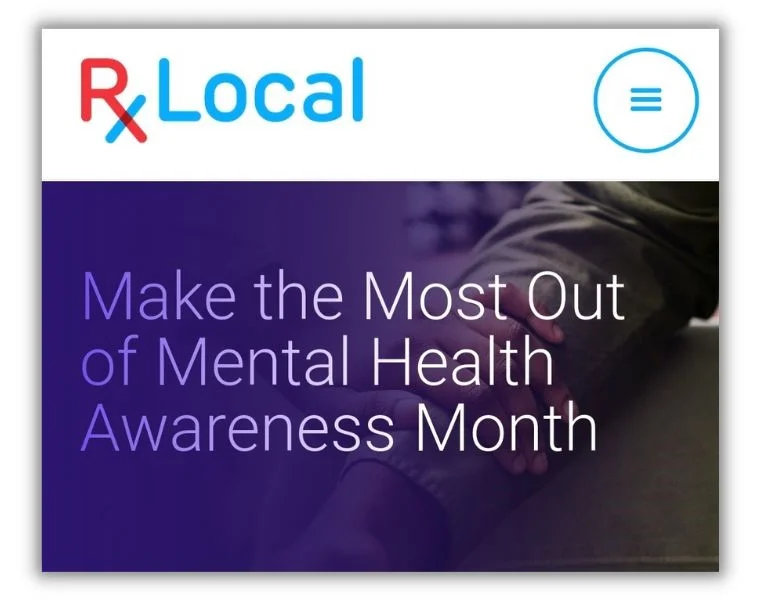

Education, empathy, and accessibility are important themes for Mental Health Awareness Month. Consider them as you share content that helps your audience understand what mental health means to them.
- Invite a mental health professional to manage your social media feeds for the day, offering tips on stress reduction, conflict resolution, and other common challenges.
- Share links and phone numbers to mental health resources and care providers.
- Create a music playlist of calming music.
- If you’re comfortable with it, share a personal story of your own mental health journey.
- Promote events like 5Ks and awareness walks that support mental health organizations and missions.
National Nurses Day (May 6)
Nursing is an incredibly demanding and critical profession. Some content devoted to appreciating amazing nurses is well warranted.
You don’t need an elaborate post or to work in the medical field to express your support for nurses.


There are actually two nurse-related holidays in May: National Nurses Day (May 12) and International Nurses Day (May 13). You’ll need a few content ideas to fill out both days.
- List a few types of nurses and explain what those specialties do.
- Offer nurses an extra discount, or have a giveaway specifically for nurses.
- Create a list of the freebies and discounts offered to nurses by local or online shops.
- Share ways your followers can show support for the nurses in their lives.
National Rescue Dog Day (May 20)
“Adopt, don’t shop” is a common motto for dog rescues nationwide. The idea is that there is an overabundance of rescue pups available, and many are in less-than-ideal situations. Your May content can help connect these beautiful dogs with a new furever home.
I mean, look at that face!


The great thing about content for this awareness day is that people love posts with pics of pets. So, use these ideas to do some good while gaining visibility for your brand.
- This day is ripe for user-generated content, so ask your followers to share images or videos of their rescue dogs.
- Partner with local rescue organizations to feature dogs that need a good home.
- Create a list of volunteer opportunities at dog shelters, or, even better, organize a volunteer day.
- Ask a dog trainer to give training tips for new rescue dogs to help your new followers feel more comfortable adopting a pup.
Other awareness May content ideas
Still not enough ideas for you? No worries, there are plenty more to go. Choose a few great causes from this list and use them to fill in the blanks.
- ALS Awareness Month
- Brain Cancer Awareness Month
- Cancer Research Month
- National Lyme Disease Awareness Month
- National Skilled Trades Day (May 1)
- National Public Radio Day (May 3)
- International Firefighters Day (May 4)
- National Teacher Appreciation Day (May 7)
- National Ovarian Cancer Day (May 8)
- World Red Cross and Red Crescent Day (May 8)
- National Small Business Day (May 10) (Small Business Week April 28 to May 4)
- National Hospital Day (May 12)
- International Day Against Homophobia, Transphobia, and Biphobia (May 17)
- Global Accessibility Awareness Day (May 18)
- World Multiple Sclerosis Day (May 20)
- World Hunger Day (May 28)
Food and drink May content ideas
Beverages and nibbles are always content crowdpleasers because, well, everyone eats and drinks. Get a few of these ideas in your content mix this May for an extra hit of attention.
National Give Someone a Cupcake Day (May 8)
Some say cupcakes are just muffins with better makeup, but we say they’re a confection worth commemorating. National Give Someone a Cupcake Day lets you honor this handheld sweet treat while sharing a little joy.


If you have a physical location, hand out a few dozen of the best cupcakes you can find and promote the event on social media. If you’re not a local business, there are still ways to spread the joy of a perfectly iced walking cake.
- Share the secrets of your staff’s favorite cupcake recipes or go-to bakeries.
- Ask followers to tag you in videos of them giving their family and friends cupcakes.
- Ask a baker to write healthier alternatives to some ingredients in typical cupcake recipes, like processed sugar and flour, and then share them in a post.
- Post a funny cupcake image and challenge people to suggest captions for it.
National Barbecue Day (May 16)
People are proud of their regional barbeque. Whether it’s Texas, Memphis, or the Carolinas, everyone knows their ‘que is the best and is willing to make fun of every other version.
Where there’s good-natured ribbing (pun intended), there’s lots of engagement on social media posts. Take advantage by posting about the “best” barbeque on May 16th.
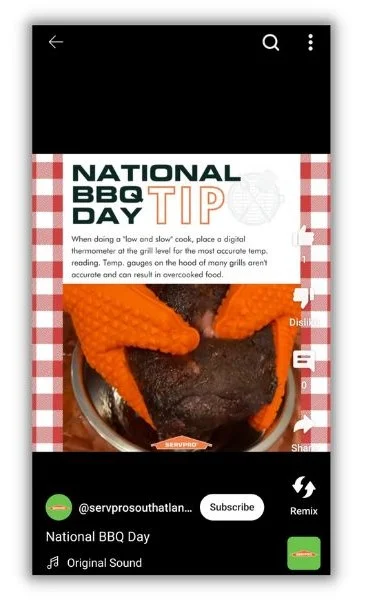

Here are a handful of ways to get the ‘que conversation started in your May content:
- Poll people about their favorite cooking method or sauce.
- Create an infographic of barbeque styles.
- Write a blog post detailing the best BBQ restaurants in your city.
- Share interesting facts about BBQ (like that the world record-holder ate over 13 pounds of ribs in 12 minutes).
Eat More Fruits and Vegetables Day (May 21)
It can’t all be roasted meat and icing. You have to include some produce, too. And that’s what Eat More Fruits and Vegetables Day is all about.
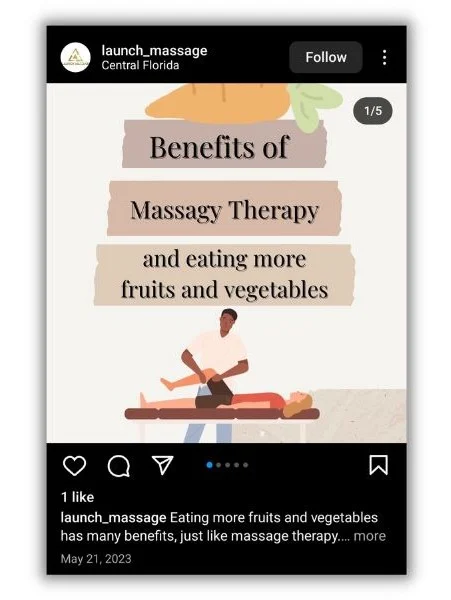

Although it may not be as fun as other food-related holidays, you can still create interesting, helpful content.
- Partner with other local businesses, such as gyms, massage therapists, nutritionists, and health food stores, to promote an online health fair.
- Create a chart listing the main health benefits of several fruits and vegetables.
- Promote local farms and farmers’ markets.
- Share a list of produce growing locally and when it’s in season.
- Work with a local restaurant to curate several easy, healthy recipes featuring in-season fruits and vegetables.
Other food and drink content ideas
Hardly a week goes by in May without several days dedicated to one food or another. You could even have a social media post listing them all. Or, pick a few from the list and create some mouth-watering content around it.
- American Cheese Month
- National Chocolate Parfait Day (May 1)
- National Truffle Day (May 2)
- National Coconut Cream Pie Day (May 8)
- International Hummus Day (May 13)
- National Chocolate Chip Day (May 15)
- National Mushroom Hunting Day (May 17)
- National Pizza Party Day (May 17)
- World Baking Day (May 19)
- National Wine Day (May 25)
Warm up your marketing channels with these May content ideas
There’s a palpable buzz in May that’s fueled by thoughts of outdoor gatherings, road trips, and days playing at the pool. When your May content matches that vibe, you’ll stand out in feeds, inboxes, and Google searches. And if you want all of your marketing efforts to generate more leads and sales, see how our marketing solutions can help any day of the year!
For more May marketing ideas, check out these posts:
PPC
How to Collect & Use Customer Data the Right (& Ethical) Way

Customer data is extremely valuable for many reasons, and one of the biggest is to make your marketing more effective. Customer data can act as the foundation for your marketing strategy, help you optimize and refine your campaigns, and influence the marketing messages you create.
But as privacy becomes even more important and customers pay more attention to how businesses are collecting, storing, and using their information, this is turning into a pretty big challenge for businesses—especially smaller, local businesses. So in this guide, we’ll cover everything you need to know about collecting and using customer data the right way to keep your marketing and targeting super effective.
Contents
What is customer data?
Customer data is any information about your customers or potential customers. It includes demographic information, contact information, and more (we’ll get into the types of customer data in a minute!).
It’s important to collect customer data so you can refine your campaign targeting, build segmented email lists, learn more about your audience, and more.
Before we dive into the types of customer data, let’s talk about the different sources of data:
- Zero-party data: Data customers give to businesses willingly.
- First-party data: Data businesses source directly from their customers.
- Second-party data: Data businesses have access to that they didn’t collect and don’t own. This data can come from a partner sharing data or insights.
- Third-party data: Data businesses use that have no ties to the business. This is typically collected from multiple sources and can be purchased by businesses for specific campaigns or research.

Zero- and first-party data are the best types of data collection sources to use when sourcing customer data. Why? Because they are the most transparent, least likely to infringe on privacy policies, and lead to more engaged customers and campaigns. Second- and third-party data are still helpful to inform your marketing strategies and help boost the effectiveness of other campaigns.
Types of customer data
There are four main types of customer data that you can collect—and they can help your business’s marketing efforts in different ways.
Basic data
Basic data is pretty self-explanatory. It’s the basic information about your customers, including their:
- Name
- Email address
- Phone number
- Address
- Gender
- Income
- Industry
- And more
This is essentially demographic data. Basic data is fairly easy to collect as many people are used to providing their names, email addresses, phone numbers, and addresses when placing an online order, downloading a piece of content, or signing up for a newsletter.


This information can provide the basis for your campaign targeting, can help you assess which marketing channels to use, and can inform several marketing strategies.
📚 Free guide download >> 135 of the Best Words & Phrases for Marketing with Emotion
Engagement data
Engagement data is information about how your customers engage with your business across various touchpoints. This could include their engagement with your social media sites, how they click through your website, or whether or not they click on your search ad.
Typically, businesses collect this data at a higher level rather than an individual level. Although some tools can help you see this information at a user level.


An example of engagement data for a business’s Facebook page.
This customer data can be used to assess the effectiveness of your marketing efforts, identify specific campaigns or messages that are resonating with your brand, and inform areas for improvement in your marketing strategy.
Attitudinal data
Attitudinal data is information about how customers feel about your business and your products or services. This customer data is extremely useful but is more difficult to collect.
Because this type of data comes straight from your customers, it’s usually collected as a survey or review.
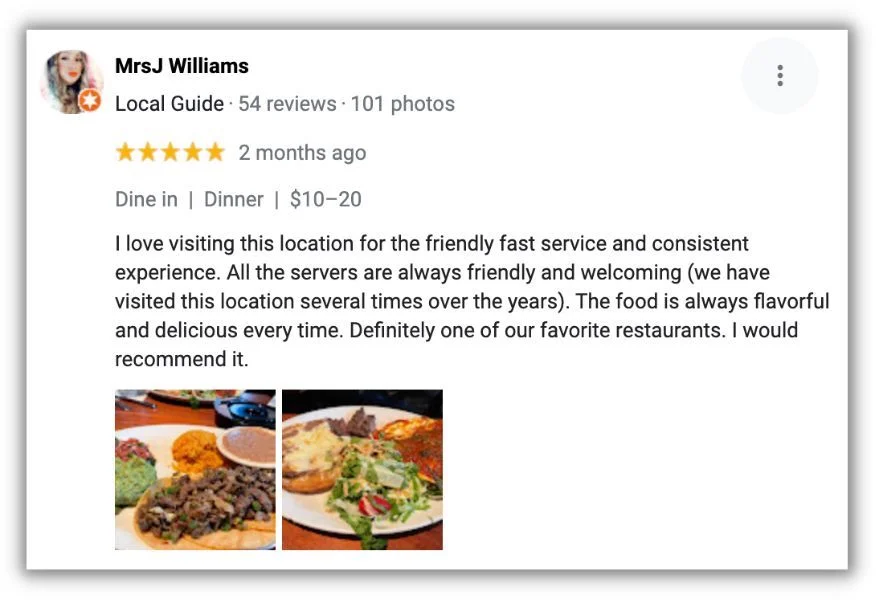

Attitudinal data can help you improve your marketing campaigns, your products and services, and your overall business operations.
Behavioral data
Behavioral data is information about how customers engage directly with your products or services. This includes past purchases, appointments scheduled, items added to a cart, and more.
This information can be collected through a variety of sources, such as a lead management platform, a POS system, and more.
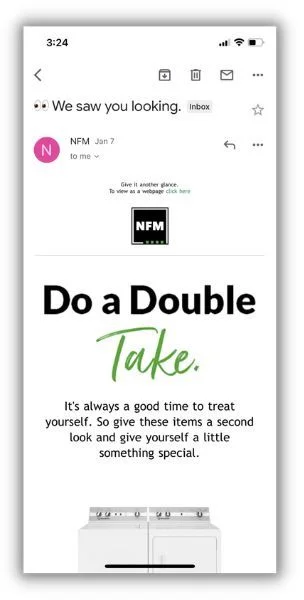

Behavioral data can impact your nurture campaigns, promotions, and more.
How to collect customer data
There are many different ways to collect customer data without infringing on your customers’ rights or violating their privacy. We’re going to focus on some zero- and first-party customer data collection methods.
Here are some options for collecting customer data.
1. Build an email list
Building an email list is one of the best ways to collect customer data. You can build an email list in many different ways, including:
- Having people sign up for your newsletter
- Adding a contact form to your website
- Adding a contact form to your landing pages
- Creating a quiz where customers get their results in exchange for an email address
- And a few other options we’ll talk about shortly


Building an email list will help you collect basic and engagement data and set the stage to help you collect additional data through some of our other ideas.
🛠️ Get the tools and tips you need to build the perfect landing page in our free guide >> How to Make Great Landing Pages (with Crazy-High Conversion)
2. Send a survey
One of the best ways to learn more about your customers and prospects is to ask them! You can do this through surveys, which can be sent via email, added as a link on your website, or included as a link on your invoicing or receipts.
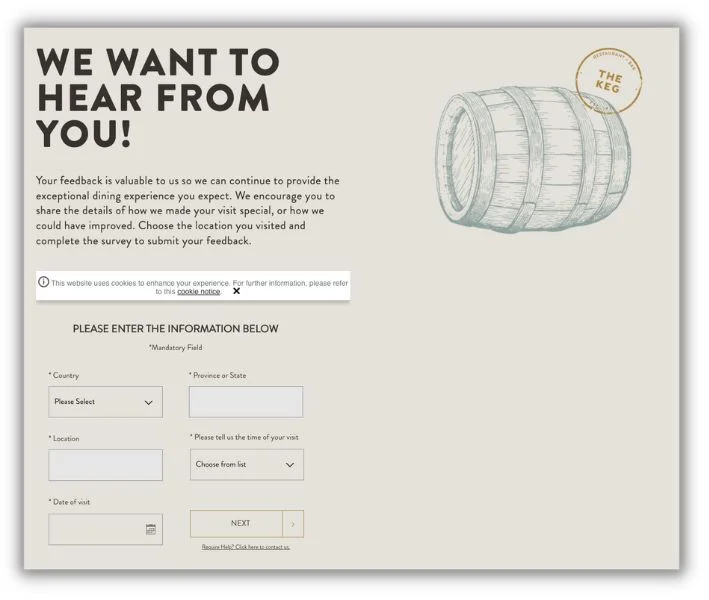

The questions in your survey will depend on the type of customer data you’re hoping to collect.
For example, if you want to collect basic data, your survey will likely read more like a lead collection form that includes spaces for your customer’s name, phone, number address, and occupation.
If you want to collect the ever-elusive attitudinal data, your survey will focus more on how customers perceive your business, your products, and your services.
You can also survey your customers to find out information that may influence behavioral data, such as what social media sites they’re active on, where they’ve seen your business online, and what types of content they’re interested in seeing from your business.
3. Run a contest
Whether you’re looking to build your email list or see a change in engagement data, running a contest is a great customer data collection method.
In exchange for the valuable information you’re collecting from your customers, you’ll want to make sure the prize is compelling and that you promote your contest on the channels your customers are most likely to engage—probably social media, through email, and on your website.


4. Use a lead management system
One of the best ways to collect customer data and learn more about your customers is by using a lead management system. A lead management system tracks where your leads are coming from, how they’ve engaged with your business online, and their behavior with your products or services.
A lead management system that uses a single lead inbox can also aggregate your customer data and help you identify interesting trends that can impact your overall marketing strategy and how you spend your budget.
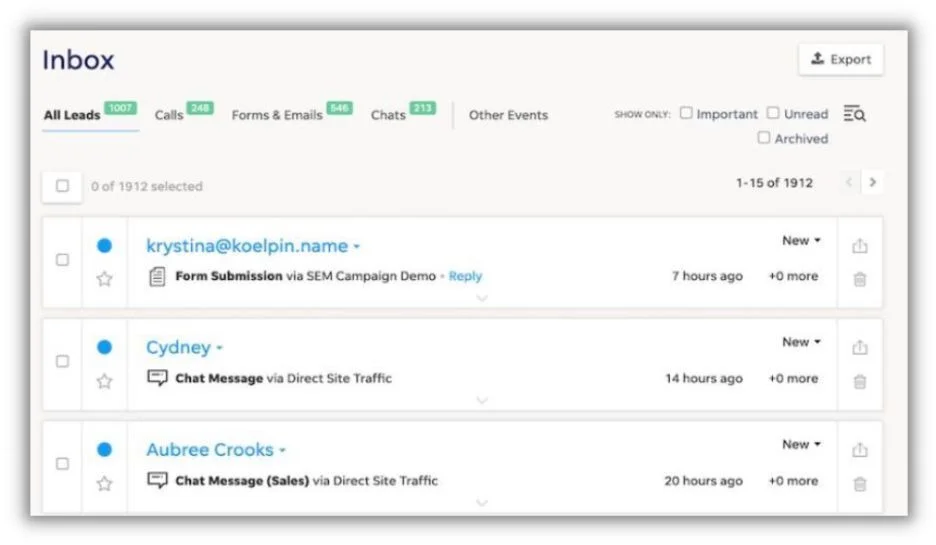

This data customer collection method can also help you learn more about your specific customers’ journey—including how many touchpoints it takes a lead to convert or what marketing channels convert at the highest rate.
5. Offer a free downloadable resource
Another great way to build your email list and collect customer data is to provide a free downloadable resource that relates to your business.
While this is a popular tactic in the B2B world, it can also work really well for B2C businesses. For example, a cleaning business can provide a downloadable spring cleaning checklist or a dentist can provide a downloadable guide on the foods to avoid for healthy teeth.
The goal is to make your resource compelling enough for a prospect or customer to provide their information in exchange for what you’re offering.
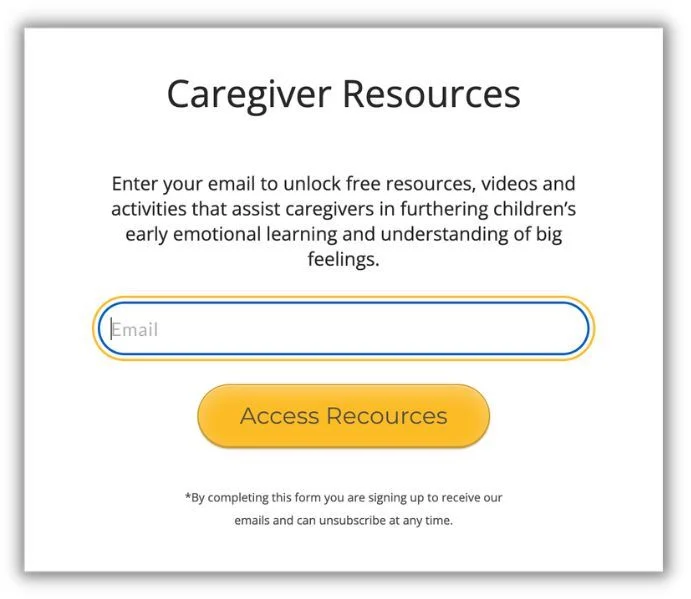

By offering multiple downloadable resources, you can also collect customer data about the topics that drive the most downloads and tailor your content creation or campaigns to those topics or messages.
How to use customer data for marketing
We’ve touched a little on how the types of customer data can impact your marketing, but let’s dive a little deeper now that you have some ideas on how to collect it.
Identify the right marketing channels
When you understand more about your customers, including their demographic information and where they spend time online, you can choose the right marketing channels that will make the biggest impact on your business.
For example, if you know that most of your customers are Gen Zers, then you can assume that TikTok, Snapchat, and Instagram will be big drivers for your business.
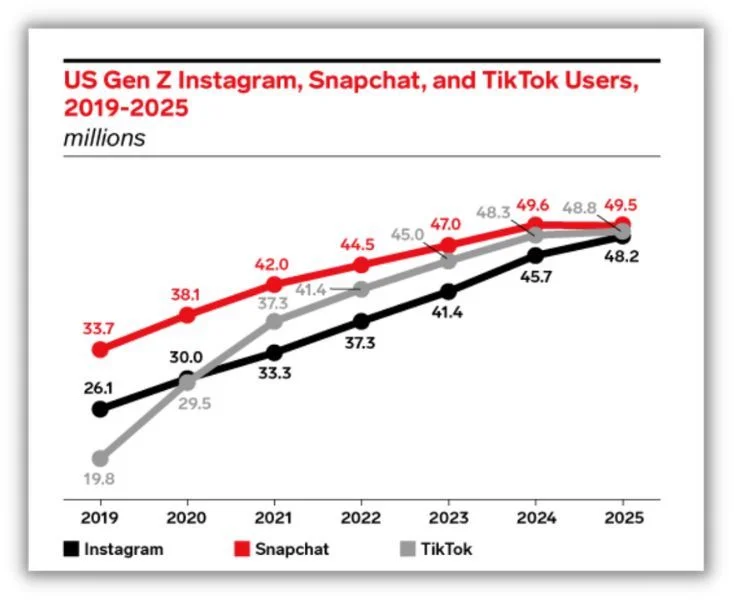

Or, if through a survey, you find that most of your current customers found your business on Google, then you might consider focusing more of your marketing efforts on search ads and SEO so you can capture more customers there.
Through collecting customer data, you may also identify some new channels that you hadn’t considered—which can help you test new strategies and make your marketing even more effective.
Refine marketing messages
When you understand how your customers engage with your business, what drives them to make a purchase with you, and their top pain points, you can better refine your marketing messages. This helps you personalize your marketing strategy to your most likely customers, which can drive better results.
For example, after sending a survey to your plumbing customers, you may have found that most of them value your quick response time to emergency jobs. You can then use this information in your ad copy, on your website, and in your social media posts to influence potential new customers to give you a call or think of you when they have an emergency.


Optimize campaigns
Better understanding your target market through customer data is extremely helpful for optimizing your campaigns and overall marketing strategy.
And even the most basic data about your customers can help. For example, location data makes up the foundation of many paid advertising campaigns, so by understanding that most of your customers are in a specific suburb, you can optimize your ad targeting to reach them.


You can also optimize your ad copy using feedback from your refined marketing messages and identify specific searches that drove customers to your website or to click on your ad.
🎯 Need targeting help? Get the guide >> 10 Facebook Ad Targeting Strategies That Work In a Privacy-First World
Personalize your marketing
Personalization is no longer a “nice to have” when it comes to effective marketing. It’s a necessity. And you can’t personalize your marketing without access to customer data.
Customer data can help you segment your audiences, which leads to better-targeted ad campaigns or email marketing messages.
For example, within your lead management system, you could tag customers who previously purchased your teeth whitening package and then send them emails about teeth whitening specials or content on how to keep your teeth clean, since this is likely a topic they’re interested in. These targeted messages can help customers feel like they’re getting a personalized experience and lead them to take action.


Customer data can also help influence the type of content you create, which helps create a more personalized experience for your customers. This content can be distributed across social media, your website, your newsletter, and more, which leads to more engagement on your marketing channels.
Influence nurture sequences
When you collect customer data that helps you understand your buyer’s journey, you can create nurture sequences meant to increase conversions.
Email nurturing is when you send a series of emails meant to drive prospects through the sales funnel until they convert into a customer.
By collecting customer data about how your customers engage with your business throughout the funnel, you can optimize your nurture sequences to identify the right path for segments of potential customers.
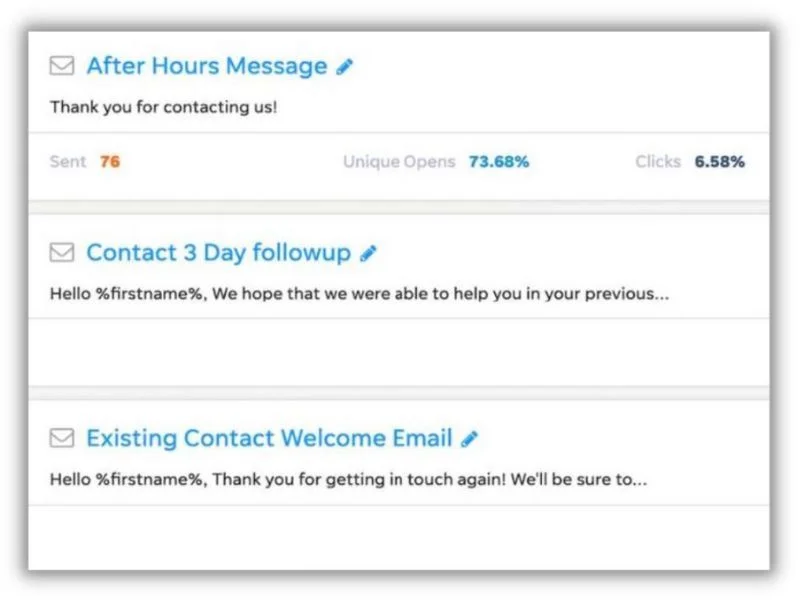

For example, say you’re an SAT prep center. You might find that an email with tips for helping your child study for the SATs followed by an email from a parent and student testimonial who received stellar scores after preparing with your SAT prep center drove a high volume of calls or classes scheduled. That would then be a compelling nurture sequence to continue testing for better results.
Tips for ethical customer data collection and storage
We can’t end this post without touching on some important tips for collecting and storing customer data.
- Include unsubscribe buttons: Every email you send to your email list should include an unsubscribe button so people can opt out at any time.
- Create a privacy policy—and publish it on your website: A privacy policy that outlines how you collect, use, and store customer data is essential. Make sure to publish it on your website and include it any time customers are providing their data or opting into your email list.
- Protect customer data: Any business that collects customer data is at risk for a security breach. Take extra steps to protect your customers and their data.
- Be transparent: Communicate with your customers or prospects if a breach happens, if you update your privacy policy, or if there’s any threat to their data.
- Try a double opt-in: A double opt-in is becoming more standard as it ensures customers know what information they’re providing to businesses. It can also lead to a more engaged email list!
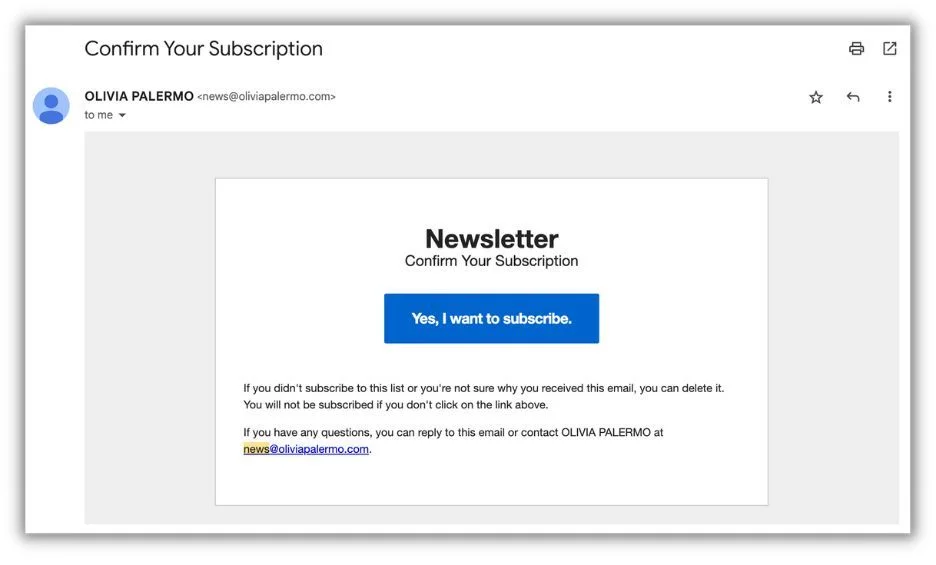

Example of a double opt-in email.
Collect and use customer data the right way
Collecting and using customer data can be tricky—if you don’t do it right. By using these zero- and first-party collection methods, you can get access to valuable customer data without infringing on your customers’ rights or making customers feel uncomfortable.
As second- and third-party data collection become murkier, these methods will help you find customer data and use it right.
-

 SEARCHENGINES6 days ago
SEARCHENGINES6 days agoGoogle Core Update Volatility, Helpful Content Update Gone, Dangerous Google Search Results & Google Ads Confusion
-

 SEO6 days ago
SEO6 days ago10 Paid Search & PPC Planning Best Practices
-

 MARKETING7 days ago
MARKETING7 days ago2 Ways to Take Back the Power in Your Business: Part 2
-

 MARKETING5 days ago
MARKETING5 days ago5 Psychological Tactics to Write Better Emails
-

 SEARCHENGINES5 days ago
SEARCHENGINES5 days agoWeekend Google Core Ranking Volatility
-

 SEO6 days ago
SEO6 days agoWordPress Releases A Performance Plugin For “Near-Instant Load Times”
-

 MARKETING6 days ago
MARKETING6 days agoThe power of program management in martech
-
SEARCHENGINES4 days ago
Daily Search Forum Recap: April 15, 2024















